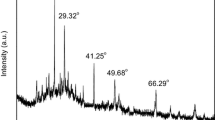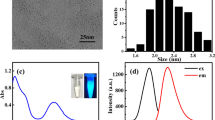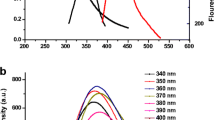Abstract
In the present article, a novel and effective ZnO quantum dots-based fluorescent probe has been developed for the detection of cysteine in different solutions. Firstly, melamine-based fluorescent pre-probe was successfully synthesized via condensation reaction and, then ZnO quantum dots (QDs) were homogenously dispersed into this solution. This fluorescent probe was used for the detection of cysteine in different solutions such as bovine serum albumin and tap water. ZnO QDs were characterized using XRD, nano-particle size analyzer, and FE-SEM techniques. The size of the ZnO QDs was calculated as 28.03±9.86 nm, and 31.95±10.02 nm from Scherrer’s equation and nano-particle size analyzer, respectively. The developed fluorescent probe was exhibited a highly selective and sensitive response to the detection of cysteine. Also, the proposed fluorescent probe has a larger Stokes shift value (236 nm). The limit of detection and linear range of ZnO QDs-based fluorescent biosensor were found as 0.642 μM and 0.1–600 μM, respectively.

ZnO quantum dot-based fluorescent sensor for L-cysteine









Similar content being viewed by others
References
Fonoberov VA, Balandin AA (2006) ZnO quantum dots: Physical properties and optoelectronic applications. J Nanoelectron Optoelectron 1:19–38
Gulia S, Kakkar R (2013) ZnO quantum dots for biomedical applications. Adv Mat Lett 4:876–887
Udhayakumari D (2020) Detection of toxic fluoride ion via chromogenic and fluorogenic sensing. A comprehensive review of the year 2015–2019. Spectrochim Acta A 228:117817
Farshbaf M, Davaran S, Rahimi F, Annabi N, Salehi R, Akbarzadeh A (2018) Carbon quantum dots: recent progresses on synthesis, surface modification and applications. Artif Cell Nanomed B 46:1331–1348
Li Y, Xu X, Wu Y, Zhuang J, Zhang X, Zhang H, Lei B, Hu C, Liu Y (2020) A review on the effects of carbon dots in plant systems. Mater Chem Front 4:437–448
Zhao X, Liao S, Wang L, Liu Q, Chen X (2019) Facile green and one-pot synthesis of purple perilla derived carbon quantum dot as a fluorescent sensor for silver ion. Talanta 201:1–8
Zou T, Xing X, Yang Y, Wang Z, Wang Z, Zhao R, Zhang X, Wang Y (2020) Water-soluble ZnO quantum dots modified by (3-aminopropyl) triethoxysilane: The promising fluorescent probe for the selective detection of Cu2+ ion in drinking water. J Alloys Compd 825:153904
Wang C, Shi H, Yang M, Yan Y, Liu E, Ji Z, Fan J (2020a) Facile synthesis of novel carbon quantum dots from biomass waste for highly sensitive detection of iron ions. Mater Res Bull 110730:124
Wang C, Shi H, Yang M, Yan Y, Liu E, Ji Z, Fan J (2020b) A novel nitrogen-doped carbon quantum dots as effective fluorescent probes for detecting dopamine. J Photoch Photobio A 391:112374
Ge Q, Kong WH, Liu XQ, Wang YM, Wang LF, Ma N, Li Y (2020) Hydroxylated graphene quantum dots as fluorescent probes for sensitive detection of metal ions. Int J Miner Metall Mater 27:91–99
Wang S, Chu X, Xiang X, Cao Y (2020c) Highly selective antenna effect of graphene quantum dots (GQDs): A new fluorescent sensitizer for rare earth element terbium in aqueous media. Talanta 209:120504
Cai L, Zhang Z, Xiao H, Chen S, Fu J (2019) An eco-friendly imprinted polymer based on graphene quantum dots for fluorescent detection of p-nitroaniline. RSC Adv 9:41383–41391
Wang Y, Wang Y, Liu H (2019a) A novel fluorescence and spe adsorption nanomaterials of molecularly imprinted polymers based on quantum dot-grafted covalent organic frameworks for the high selectivity and sensitivity detection of ferulic acid. Nanomaterials 9:305
Adegoke O, Pereira-Barros MA, Zolotovskaya S (2020) Aptamer-based cocaine assay using a nanohybrid composed of ZnS/Ag2Se quantum dots, graphene oxide and gold nanoparticles as a fluorescent probe. Microchim Acta 187:104
Zhou ZQ, Liao YP, Yang J, Huang S, Xiao Q, Yang LY, Liu Y (2020) Rapid ratiometric detection of Cd2+ based on the formation of ZnSe/CdS quantum dots. Spectrochim Acta A 228:117795
Fu H, Hu O, Fan Y, Hu Y, Huang J, Wang Z, She Y (2019) Rational design of an “on-off-on” fluorescent assay for chiral amino acids based on quantum dots and nanoporphyrin. Sens Actuators B Chem 287:1–8
Zhang Y, Xiao Y, Zhang Y, Wang Y (2020) Carbon quantum dots as fluorescence turn-off-on probe for detecting Fe3+ and ascorbic acid. J Nanosci Nanotechnol 20:3340–3347
Ensafi AA, Nasr-Esfahani P, Rezaei B (2017) Quenching-recovery fluorescent biosensor for DNA detection based on mercaptopropionic acid-capped cadmium telluride quantum dots aggregation. Sens Actuators B Chem 249:149–155
Liang SS, Qi L, Zhang RL, Jin M, Zhang ZQ (2017) Ratiometric fluorescence biosensor based on CdTe quantum and carbon dots for double strand DNA detection. Sens Actuators B Chem 244:585–590
Bano D, Kumar V, Chandra S, Singh VK, Mohan S, Singh DK, Talat M, Hasan SH (2019) Synthesis of highly fluorescent nitrogen-rich carbon quantum dots and their application for the turn-off detection of cobalt (II). Opt Mater 92:311–318
Fana L, Wanga Y, Lia L, Zhou J (2020) Carbon quantum dots activated metal organic frameworks for selective detection of Cu(II) and Fe(III). Colloids Surf A Physicochem Eng Asp 124378:588
Fakhroueian Z, Vahabpour R, Assmar M, Massiha A, Zahedi A, Esmaeilzadeh P, Katouzian F, Rezaei S, Keyhanvar P, Dehshir AM (2018) ZnO Q-dots as a potent therapeutic nanomedicine for in vitro cytotoxicity evaluation of mouth KB44, breast MCF7, colon HT29 and HeLa cancer cell lines, mouse ear swelling tests in vivo and its side effects using the animal model. Artif Cell Nanomed B 46:96–111
Wang X, Xu K, Yan X, Xiao X, Aruta C, Foglietti V, Ning Z, Yang N (2020d) Amorphous ZnO/PbS quantum dots heterojunction for efficient responsivity broadband photodetectors. ACS Appl Mater Interfaces 12:8403–8410
Li SH, Mou QQ, Qianqian, Leung PHM (2017a) Synthesis of photoluminescent ZnO quantum dots and its application in bioimaging. Nanosci Nanotech Lett 9:1514–1519
Zhang X, Lan W, Xu J, Luo Y, Pan J, Liao C, Yang L, Tan W, Huang X (2019) ZIF-8 derived hierarchical hollow ZnO nanocages with quantum dots for sensitive ethanol gas detection. Sens Actuators B Chem 289:144–152
Xu B, Cao Q, Zhang Y, Yu W, Zhu J, Liu D, Jiang G (2018) Microneedles integrated with ZnO quantum-dot-capped mesoporous bioactive glasses for glucose-mediated insulin delivery. Biomater Sci Eng 4:2473–2483
Jensen KS, Hansen RE, Winther JR (2009) Kinetic and thermodynamic aspects of cellular thiol–disulfide redox regulation. Antioxid Redox Signal 11:1047–1058
Wang XD, Fan L, Ge JY, Li F, Zhang CH, Wang JJ, Shuang SM, Dong C (2019b) A lysosome-targetable fluorescent probe for real-time imaging cysteine under oxidative stress in living cells. Spectrochim Acta A 221:117175
Paulsen CE, Carroll KS (2013) Cysteine-mediated redox signaling: Chemistry, biology, and tools for discovery. Chem Rev 113:4633–4679
Sun W, Tang X, Li J, He M, Zhang R, Han X, Zhao Y, Ni Z (2020) A novel 4-hydroxypyrene-based “off–on” fluorescent probe with large Stokes shift for detecting cysteine and its application in living cells. Tetrahedron Lett 61:151467
Wang JY, Liu ZR, Ren M, Kong X, Lin W (2017) A fast-response two-photon fluorescent probe for the detection of Cys over GSH/Hcy with a large turn-on signal and its application in living tissues. J Mater Chem B 5:134–138
Lai Q, Liu Q, Zhao K, Duan X, Wang G, Su X (2019) Fluorometric determination and intracellular imaging of cysteine by using glutathione capped gold nanoclusters and cerium (III) induced aggregation. Microchim Acta 186:327
Duru Kamaci U, Kamaci M, Aysegul P (2019) Poly(azomethine-urethane) and zeolite-based composite: Fluorescent biosensor for DNA detection. Spectrochim Acta A 212:232–239
Kamaci M, Kaya I (2016) New low-band gap polyurethanes containing azomethine bonding: Photophysical, electrochemical, thermal and morphological properties. J Taiwan Inst Chem E 59:536–546
Kamaci M, Kaya I (2018) Melamine-based poly(azomethine) hydrogels: Mechanical, biodegradability, drug loading and antibacterial properties. Eur Polym J 108:107–115
Kaya I, Yıldırım M, Kamaci M (2011) A new kind of optical Mn (II) sensor with high selectivity: Melamine based poly(azomethine-urethane). Synth Met 161:2036–2040
Chen Z, Li XX, Du G, Chen N, Suen AYM (2011) A sol–gel method for preparing ZnO quantum dots with strong blue emission. J Lumin 131:2072–2077
Hamizi NA, Johan MR, Ghazali N, Wahab YA, Chowdhury ZZ, Akbarzadeh O, Sagadevan S, Badruddin IA, Khan TMY, Kamangar S (2019) Lattice strain analysis of a Mn-doped CdSe QD system using crystallography techniques. Processes 7:639
Gutul T, Rusu E, Condur N, Ursaki V, Goncearenco E, Vlazan P (2014) Preparation of poly(N-vinylpyrrolidone)-stabilized ZnO colloid nanoparticles. Beilstein J Nanotechnol 5:402–406
Vidhya K, Saravanan M, Bhoopathi G, Devarajan VP, Subanya S (2015) Structural and optical characterization of pure and starch-capped ZnO quantum dots and their photocatalytic activity. Appl Nanosci 5:235–243
Li L, Liao L, Ding Y, Zeng H (2017b) Dithizone-etched CdTe nanoparticles-based fluorescence sensor for the off–on detection of cadmium ion in aqueous media. RSC Adv 7:10361–10368
Pletnev S, Pletneva NV, Souslova EA, Chudakov DM, Lukyanov S, Wlodawer A, Dautera Z, Pletnev V (2012) Structural basis for bathochromic shift of fluorescence in far-red fluorescent proteins eqFP650 and eqFP670. Acta Cryst D68:1088–1097
Kamaci M, Kaya I (2015) 2,4-Diamino-6-hydroxypyrimidine based poly(azomethine-urethane): Synthesis and application as a fluorescent probe for detection of Cu2+ in aqueous solution. J Fluoresc 25:1339–1349
Li M, Zheng K, Chen H, Liu X, Xiao S, Yan J, Tan X, Zhang N (2019) A novel 2,5-bis(benzo[d]thiazol-2-yl)phenol scaffold-based ratiometric fluorescent probe for sensing cysteine in aqueous solution and serum. Spectrochim Acta A 217:1–7
Chen Y, Qin X, Yuan C, Wang Y (2020) Switch on fluorescence mode for determination of L-cysteine with carbon quantum dots and Au nanoparticles as a probe. RSC Adv 10:1989–1994
Hager G, Brolo AG (2009) Protonation and deprotonation of cysteine and cystine monolayers probed by impedance spectroscopy. J Electroanal Chem 625:109–116
Rad GD, Asghari K, Tavallali H (2020) Development of a reversible indicator displacement assay based on the 1-(2-Pyridylazo)-2-naphthol for colorimetric determination of cysteine in biological samples and its application to constructing the paper test strips and a molecular-scale set/reset memorized device. Appl Biochem Biotechnol 192:85–102
Kamaci M, Kaya I (2017) A highly selective, sensitive and stable fluorescent chemosensor based on Schiff base and poly(azomethine-urethane) for Fe3+ ions. J Ind Eng Chem 46:234–243
Wang C, Lan Y, Yuan F, Fereja TH, Lou B, Han S, Li J, Xu G (2020e) Chemiluminescent determination of L-cysteine with the lucigenin-carbon dot system. Microchim Acta 187:50
Li Y, Shen C, Li X, Yang M, Shao C (2018) Hydroxyapatite nanoparticle based fluorometric determination and imaging of cysteine and homocysteine in living cells. Microchim Acta 185:271
Manibalan G, Murugadoss G, Thangamuthu R, Kumar MR, Kumar RM (2020) CeO2-based heterostructure nanocomposite for electrochemical determination of L-cysteine biomolecule. Inorg Chem Commun 113:107793
Ojha RP, Mishra R, Singh P, Nirala NR, Prakash R (2020) A composite prepared from MoS2 quantum dots and silver nanoparticles and stimulated by mercury (II) is a robust oxidase mimetic for use in visual determination of cysteine. Microchim Acta 187:74
Yao J, Liu C, Liu L, Chen M, Yang M (2018) An electrochemical sensor for sensitive determination of L-cysteine and its electrochemical kinetics on AgNPs/GQDs/GCE composite modified electrode. J Electrochem Soc 165:B551–B558
Availability of Data and Material
All data generated or analyzed during this study are included in this published article.
Author information
Authors and Affiliations
Contributions
Umran DURU KAMACI: Conceptualization, Methodology, Formal analysis, Writing. Musa KAMACI: Conceptualization, Investigation, Visualization, Writing - review & editing.
Corresponding author
Ethics declarations
Conflict of Interest
The authors declare that they have no known competing financial interests or personal relationships that could have appeared to influence the work reported in this paper.
Additional information
Publisher’s Note
Springer Nature remains neutral with regard to jurisdictional claims in published maps and institutional affiliations.
Rights and permissions
About this article
Cite this article
Kamaci, U.D., Kamaci, M. Selective and Sensitive ZnO Quantum Dots Based Fluorescent Biosensor for Detection of Cysteine. J Fluoresc 31, 401–414 (2021). https://doi.org/10.1007/s10895-020-02671-3
Received:
Accepted:
Published:
Issue Date:
DOI: https://doi.org/10.1007/s10895-020-02671-3




